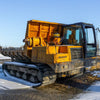The Technical Standards Your PPE Needs to Conform to During COVID-19

Those working within industries that require the use of PPE will already be familiar with EU Regulation 2016/425 on Personal Protective Equipment, which outlines the necessary technical requirements which a garment must meet in order to adequately protect the wearer from the specific risks within the relevant working environments and conditions.
Across Europe, wearers have typically looked for the CE mark on their PPE, which provides a singular confirmation that the clothing meets the necessary health, safety, and environmental standards that are set out in the European Economic Area (EEA).
However, due to increased demand for PPE, and an urgent need to meet this demand during the COVID-19 outbreak, the UK Government has permitted fast-tracked PPE to be circulated without the CE mark. To ensure that these garments are effective, a revised list of technical standards has been introduced for certain items of clothing.
So, what technical standards does your PPE need to conform to during the pandemic?
As of 30th March 2020, manufacturers of COVID-19 PPE must ensure that the following technical standards are met for masks, eye protection, gloves, gowns, and coveralls:
- Surgical Face Masks: All surgical face masks must have a bacterial filtration efficiency rate of 95%, or 98% for Type II masks, and differential pressure of under 40Pa/cm2. Surgical face masks should be tested to the BS EN 14683 standard.
- Respirator Face Masks: Respirator face masks must have two elastic straps to fit the head and neck. These may or may not be adjustable. Filtering half masks should meet the BS EN 149:2001 standards for Respiratory Protective Devices.
- Eye Protection: Personal eye protection, including visors and face shields, should be transparent, fog, droplet, and splash resistant, and allow for adjusting. All items should meet the BS EN 166:2002 standard for Personal Eye Protection.
- Coveralls: Most coveralls and boiler suits must meet the BS EN 13034:2005 (or A1:2009) standard for protection against liquid chemicals. Many garments will also need to meet the EN14126 standard if used in areas with infective agents.
- Surgical Gloves: Surgical gloves must be made from polyisoprene, polychloroprene, nitrile, latex, or neoprene, with a Sterility Assurance Level of 10-6. They must also meet BS EN 455-1 or BS EN ISO 374-2 to ensure no holes.
- Surgical Gowns: Surgical gowns must have a Sterility Assurance Level of 10-6 and meet the BS EN 13795-1:2019 standard for Surgical Clothing and Drapes. Additional liquid penetration criteria are in place for high performance gowns.
In addition, all manufacturers of PPE during the COVID-19 pandemic must be able to prove that they have a clear quality management system in place. This is usually determined by ISO 9001 certification, or testing to the BS EN 13485 regulatory standard.
While it is important for all PPE during the pandemic to meet these technical standards, it is vital to note that the UK Government classifies these standards as ‘minimally acceptable’. Where possible, it is always best to select the highest quality personal protective equipment offered by established manufacturers such as Wearwell that offer a greater level of protection to ensure workers remain safe and healthy at challenging times.
Browse our high quality workwear here: https://shop.wearwell.co.uk





